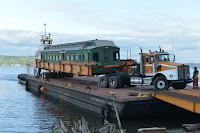 This spring the Northwest Railway Museum uncorked a new option on its train excursion schedule! On April 14 and May 19, the first two Snoqualmie Valley Wine Trains were hosted by the Museum with support from Savor Snoqualmie Valley. Both wine trains sold out in less than 10 days, much to the delight of the organizers. During these 21+ only events, guests enjoyed the scenic train ride combined with stops to sample local wine and food.
This spring the Northwest Railway Museum uncorked a new option on its train excursion schedule! On April 14 and May 19, the first two Snoqualmie Valley Wine Trains were hosted by the Museum with support from Savor Snoqualmie Valley. Both wine trains sold out in less than 10 days, much to the delight of the organizers. During these 21+ only events, guests enjoyed the scenic train ride combined with stops to sample local wine and food. Participants began their journey by checking in at the historic Snoqualmie Depot to pick up their tasting tokens and commemorative wine glass. Two wineries were immediately available for tasting opportunities in the depot’s freight room.
Participants began their journey by checking in at the historic Snoqualmie Depot to pick up their tasting tokens and commemorative wine glass. Two wineries were immediately available for tasting opportunities in the depot’s freight room.  Guests then boarded the train for the ride to the upper Snoqualmie Valley, including the view of Mount Si from historic Bridge 35, above the Snoqualmie River. Following that scenic pause, guests stopped for 40 minutes at the Museum’s Train Shed Exhibit building for wine tasting with all of the participating wineries as well as food samples from local valley food providers. Guests had time to leisurely taste more wines, grab food ‘niblets’, listen to live music provided by the talented members of Tinkham Road and wander amongst the exhibited trains.
Guests then boarded the train for the ride to the upper Snoqualmie Valley, including the view of Mount Si from historic Bridge 35, above the Snoqualmie River. Following that scenic pause, guests stopped for 40 minutes at the Museum’s Train Shed Exhibit building for wine tasting with all of the participating wineries as well as food samples from local valley food providers. Guests had time to leisurely taste more wines, grab food ‘niblets’, listen to live music provided by the talented members of Tinkham Road and wander amongst the exhibited trains.  Following the stop at the Train Shed, passengers re-boarded the train for the breathtaking view from the top of Snoqualmie Falls and the river valley below. A final stop was made at the Puget Sound Energy Hydro Museum, where guests were welcomed for a final wine tasting and the chance to enjoy a variety of Boehm’s Chocolates.
Following the stop at the Train Shed, passengers re-boarded the train for the breathtaking view from the top of Snoqualmie Falls and the river valley below. A final stop was made at the Puget Sound Energy Hydro Museum, where guests were welcomed for a final wine tasting and the chance to enjoy a variety of Boehm’s Chocolates.  The special Wine Train excursion ended with the trip back to the Snoqualmie Depot where passengers could purchase bottles of their favorite wines. Historic downtown Snoqualmie merchants welcomed Wine Train riders with special dinner and shopping opportunities too.
The special Wine Train excursion ended with the trip back to the Snoqualmie Depot where passengers could purchase bottles of their favorite wines. Historic downtown Snoqualmie merchants welcomed Wine Train riders with special dinner and shopping opportunities too.
Many thanks to all of the participating wineries: Mount Si Winery, Sigillo Cellars, Wm Grassie Wine Estates, Convergence Zone Cellars, and Pearl and Stone Wine Company. Also, thank you to the food providers: Cherry Valley Dairy, Heirloom Cookshop, Carnation Farms, and Boehm’s Chocolates. And a special thank you to Jennifer McKeown and Savor Snoqualmie Valley for their help in putting these excursions together. Watch for news of upcoming Wine Train excursions in September and October!
Spike was delighted to share his photos with this article guest authored by Peggy Barchi.





























